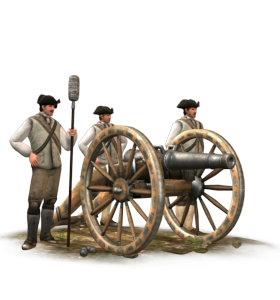18-lber Horse Guard Artillery (ETW Unit)
 Intended to keep up with rapidly-advancing mounted forces, horse artillery batteries have a touch of “cavalry dash” about them.
Intended to keep up with rapidly-advancing mounted forces, horse artillery batteries have a touch of “cavalry dash” about them.
Overview
Horse artillery units are distinguished from other types of artillery forces because everyone rides into battle: drivers ride the horses, while gun crews are often given seats on the gun limbers. The cannons assigned to horse artillery units usually fire relatively small calibre rounds although, as always, the weight of shot is used to designate different horse artillery types. The weight of fire is considered to be less important than the speed with which it can be moved to a firing position, deployed, and then removed to a new site. This is what gives horse artillery its appeal to generals: the ability to rapidly give fire from almost anywhere on the battlefield. Horse artillery can be used as a flexible reserve, or to exploit a weakness in an enemy line.
Historically, in many countries horse artillery developed a cavalry-like air of being an elite force. This attitude is entirely understandable. Dragging heavy artillery pieces across country at the gallop is an inherently dangerous thing to do, even without people shooting at you!
Tactics
This unit is unique to the French and has the advantage of being just as manoevurable as the 3 and 6 lber horse artillery available to other nations, but packing much more of a punch. Whilst it is also more expensive, it is capable standing up to heavier foot artillery batteries for a limited time and will outgun any 12 lber cannon. As such, one should replace one's smaller horse artillery units when these guns become available, if one can afford to do so.
